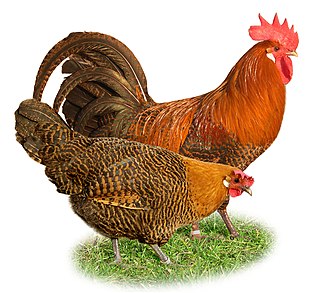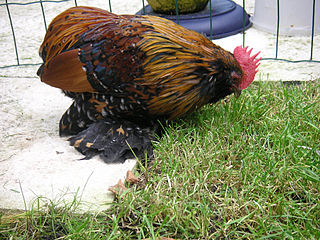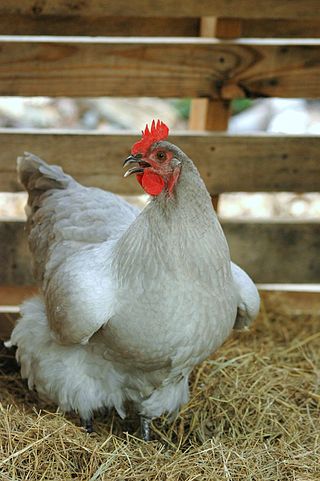
The chicken is a domesticated junglefowl species, with attributes of wild species such as the grey and the Ceylon junglefowl that are originally from Southeastern Asia. Rooster or cock is a term for an adult male bird, and a younger male may be called a cockerel. A male that has been castrated is a capon. An adult female bird is called a hen and a sexually immature female is called a pullet. Humans now keep chickens primarily as a source of food and as pets. Traditionally they were also bred for cockfighting, which is still practiced in some places.

The Braekel or Brakel is a traditional Belgian breed of chicken. It is thought to have originated in the area of Brakel, in the Flemish province of East Flanders, for which it is named. There is a bantam version of the Braekel. The Campine of the United Kingdom derives from it.

The Barbu d'Uccle or Belgian d'Uccle, Dutch: Ukkelse Baardkriel, is a Belgian breed of bearded bantam chicken. It was first bred in the town of Uccle on the outskirts of Brussels, in central Belgium, in the early years of the twentieth century. It is a true bantam, with no standard-sized large fowl counterpart, and is one of eleven Belgian true bantam breeds.

The Campine is a breed of domestic chicken originating in the northern part of Belgium. It is named for the Campine region of north-eastern Belgium and south-eastern Netherlands. It was known there as the Kempisch Hoen.

The Barbu d'Everberg, is a Belgian breed of bantam chicken. It is a tailless variant of the Barbu d'Uccle, and was bred in about 1906 at the Château d'Everberg, at Everberg in the municipality of Kortenberg, between Brussels and Leuven. It is among the most endangered chicken breeds in Belgium, and in 2010 its conservation status was classed as "critical". It is a true bantam, with no large counterpart. Cocks weigh 700–800 grams, and hens 550–650 g.

The Barbu d'Anvers, Dutch: Antwerpse baardkriel, is a breed of bantam chicken from Belgium. It is a true bantam, and has no full-sized counterpart; males weigh about 700 grams and hens about 600 g. The Barbu d'Anvers is one of the oldest bantam breeds, and is thought to have originated in the province of Antwerp in northern Flanders. It is the only Belgian bantam breed not threatened with extinction. In the United States it may be called the Antwerp Belgian or Belgian Bearded d'Anvers.

The Barbu de Watermael, Dutch: Watermaalse Baardkriel, is a Belgian breed of bantam chicken. It originated in the Belgian town of Watermael-Boitsfort, from which it takes its name, which means "bearded [chicken] from Watermael". It is closely related to the Barbu d'Anvers, but is distinguished from it by its small, backswept crest of feathers. The Barbu de Boitsfort is a rumpless variation, the only difference being that it lacks the uropygium, the part of the anatomy that carries the tail.

Lavender or self-blue refers to a plumage color pattern in the chicken characterized by a uniform, pale bluish grey color across all feathers. The distinctive color is caused by the action of an autosomal recessive gene, commonly designated as "lav", which reduces the expression of eumelanin and phaeomelanin so that black areas of the plumage appear pale grey instead, and red areas appear a pale buff.
The Barbu de Grubbe, Dutch: 'Grubbe baardkriel', is a breed of bantam chicken from Belgium. It is a true bantam, and has no full-sized counterpart; males weigh about 700 grams and hens about 600 g. It is a tail-less variant of the Barbu d'Anvers, and is otherwise similar to it in every respect. The same colour varieties are accepted for the Barbu de Grubbe as for the Barbu d'Anvers.
The Belgian Bantam, Dutch: Belgisch kriel, French: Naine belge, is a breed of bantam chicken from Belgium. It is a true bantam, and has no full-sized counterpart; cocks weigh about 650 grams and hens about 550 g. It is in danger of extinction; in 2010 a total of 168 birds were counted in the whole of Belgium. Fourteen colour patterns are recognised in the European standard.

The Ardennaise, French: Poule ardennaise, is a breed of domestic chicken from the Ardennes plateau, in Belgium and eastern France. Its range extends from the Pays de Herve in Wallonia to the French département of Ardennes, and includes the Fagnes, the Famenne, and the valleys of the Amblève, the Ourthe and the Semois.
The Barbu de Boitsfort or Dutch: Bosvoordse Baardkriel is a breed of true bantam from Belgium. It is a tail-less variety of the Barbu de Watermael, and is otherwise similar to it in every respect. It is named for the commune of Watermael-Boitsfort in the Brussels region of Belgium.
The Bassette Liégeoise or Bassette is a breed of large bantam chicken from Belgium. It is larger than most bantams, but much smaller than full-sized breeds; cocks weigh about 1000 grams and hens about 900 g. Like most Belgian bantam breeds, it is in danger of extinction. Eighteen colour patterns are officially recognised; many of them are rare.

The Malines, Dutch: Mechelse Koekoek, is a Belgian breed of large domestic chicken. It originates from the area of Mechelen, in the province of Antwerp in Flanders, for which it is named. It was created in the nineteenth century by cross-breeding local cuckoo-patterned farm chickens with various different types of imported Oriental chicken. With the Jersey Giant, it is among the heaviest of all chicken breeds. It is valued for the quality of its meat, which is pale in colour and fine-textured.
The Coucou des Flandres, Dutch: Vlaamse Koekoek, is a critically-endangered Belgian breed of domestic chicken. It may have a common origin with the Malines from the area of Mechelen, in the province of Antwerp in Flanders, or may indeed represent the original type of that breed before it was cross-bred in the nineteenth century with various different types of imported Oriental chicken. By the time of the First World War it had disappeared; it was re-created in the years before the Second World War. It is critically endangered in Belgium, but more numerous in Picardy in France. It may also be known as the Poulet de Dendre, for the Dender river in its area of origin.

The Brugse Vechter, French: Combattant de Bruges, is an endangered Belgian breed of gamecock. It dates from the early nineteenth century, and was bred specifically for cock-fighting. It named for its area of origin, that of the city of Bruges (Brugge), in West Flanders in the north-east of Belgium. It is one of three Belgian breeds of fighting-cock, the others being the Luikse Vechter and the Tiense Vechter. It is a hardy breed, but the birds are often aggressive; those reared for exhibition may show less aggression.
The Luikse Vechter, French: Combattant de Liège, is an endangered Belgian breed of gamecock. It dates from the late nineteenth century, and was bred specifically for cock-fighting. It is named for its area of origin, that of the city of Liège in Wallonia, in eastern central Belgium. It is one of three Belgian breeds of fighting-cock, the others being the Brugse Vechter and the Tiense Vechter.
The Tiense Vechter, French: Combattant de Tirlemont, is a critically-endangered Belgian breed of gamecock. It dates from the late nineteenth century, and was bred specifically for cock-fighting. It named for its area of origin, that around the city of Tienen in Flemish Brabant, in eastern central Belgium. It is one of three Belgian breeds of fighting-cock, the others being the Brugse Vechter and the Luikse Vechter.

















